|
 Value at Risk: The New Benchmark for Managing Financial Risk Value at Risk: The New Benchmark for Managing Financial Risk
HC, 600 pp, $53.55
Philippe Jorion
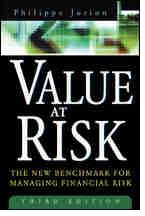 To accommodate sweeping global economic changes, the risk management field has evolved substantially since the first edition of Value at Risk, making this revised edition a must. Updates include a new chapter on liquidity risk, information on the latest risk instruments and the expanded derivatives market, recent developments in Monte Carlo methods, and more. To accommodate sweeping global economic changes, the risk management field has evolved substantially since the first edition of Value at Risk, making this revised edition a must. Updates include a new chapter on liquidity risk, information on the latest risk instruments and the expanded derivatives market, recent developments in Monte Carlo methods, and more.
This edition includes an increased emphasis on operational risk, discussion of new risk-management applications, recent changes in definitions of industry standards, and more.
Value at Risk will help professional risk managers understand, and operate within, today’s dynamic new risk environment.
Risk Management
HC, 752 pp, $39.55
Crouhy M. Galai D. Mark R.
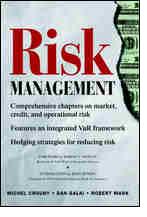 Last year's headline-grabbing stories of the notorious bailout of Long-Term Capital Management and the 1.4 billion credit loss for BankAmerica opened the eyes of the investment world. These turbulent times have meant increased awareness of risk management and have lead to late breaking developments in new research, techniques, and theories in the field. Given the high stakes in today's business world with financial dealings in the billions (e.g., derivatives), it's easy to see why risk management has become the key buzzword on Wall Street. While Jorion focuses strictly on market risk, today's financial professionals are also evaluating credit risk and operational risk. Managing Risk provides a comprehensive description and analysis of modern risk management, including the regulatory aspects, organizational issues, potential problem areas, and tools to control and manage the many different kinds of risks: market risk, credit risk, and operational risk. It also discusses: structuring and managing the risk management function in a firm; practical measurement issues in the field; risk management in both financial and non-financial institutions. Last year's headline-grabbing stories of the notorious bailout of Long-Term Capital Management and the 1.4 billion credit loss for BankAmerica opened the eyes of the investment world. These turbulent times have meant increased awareness of risk management and have lead to late breaking developments in new research, techniques, and theories in the field. Given the high stakes in today's business world with financial dealings in the billions (e.g., derivatives), it's easy to see why risk management has become the key buzzword on Wall Street. While Jorion focuses strictly on market risk, today's financial professionals are also evaluating credit risk and operational risk. Managing Risk provides a comprehensive description and analysis of modern risk management, including the regulatory aspects, organizational issues, potential problem areas, and tools to control and manage the many different kinds of risks: market risk, credit risk, and operational risk. It also discusses: structuring and managing the risk management function in a firm; practical measurement issues in the field; risk management in both financial and non-financial institutions.
Contents
The Need for Risk Management Systems. The New Regulatory and Corporate Environment. Structuring and Managing the Risk Management Function in a Bank. The New BIS Capital Requirements for Financial Risks. Measuring Market Risk: The VaR Approach. Measuring Market Risk: Extensions of the VaR Approach and Testing the Models. Credit Rating Systems. Credit Migration Approach to Measuring Credit Risk. The Contingent Claim Approach to Measuring Credit Risk. Other Approaches: The Actuarial and Reduced-form Approaches to Measuring Credit Risk. Comparison of Industry-sponsored Credit Models and Associated Back-Testing Issues. Hedging Credit Risk. Managing Operational Risk. Capital Allocation and Performance Measurement. Model Risk. Risk Management in Nonbank Corporations.
Introduction to Risk Analysis: A Systematic Approach to Science-Based Decision Making
HC, 433 pp, $89.10
Daniel M. Byrd III and C. Richard Cothern
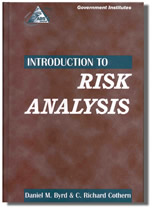 Introduction to Risk Analysis: A Systematic Approach to Science-Based Decision Making provides readers with the first comprehensive, integrated guide to developing a complete environmental risk analysis for regulated substances and processes. Introduction to Risk Analysis: A Systematic Approach to Science-Based Decision Making provides readers with the first comprehensive, integrated guide to developing a complete environmental risk analysis for regulated substances and processes.
Written for safety and loss-control, environmental, and quality managers, Introduction to Risk Analysis provides a practical introduction to the concepts of risk and its analysis. Unlike other books, Introduction to Risk Analysis looks at risk from a regulatory perspective, allowing both professionals in regulatory agencies concerned with risk including OSHA, EPA, USDA, DOT, FDA, and state environmental agencies. It enables professionals in any agency-regulated industry to understand and implement the methods required for proper risk assessment.
Authors Daniel M. Byrd, III, and C. Richard Cothern examine risk and the structure of analysis. Emphasising the predictive nature of risk, they discuss the quantitative nature of risk and explore quantitative-analysis topics, including data graphing, logarithmic thinking, risk estimating, curve fitting and Monte Carlo simulation. Many of the techniques described can be implemented with @RISK and BestFit.
Chapters include discussions on functions, models, and uncertainties; the regulatory process; risk assessment; exposure; dosimetry; epidemiology; toxicology; risk characterisation; comparative risk assessment; ecological risk assessment; risk management; and risk communication. Six in-depth case studies, an annotated bibliography, and over 50 figures are also included.
About the Authors: Daniel M. Byrd, III, is President of Consultants in Toxicology, Risk Assessment and Product Safety in Washington, DC. He has also worked in the Office of Chemical Control, the Office of Pesticide Programs, the Carcinogen Assessment Group, and the Science Advisory board at the U.S. Environmental Protection Agency. He also provides risk consulting services using @RISK.
C. Richard Cothern is a professor of Engineering Management and Chemistry at the George Washington University and a professor of Technology and Management at the University of Maryland's University College. Dr. Cothern spent 19 years with the EPA working for the Center for Environmental Statistics, the Science Advisory Board, the Offices of Drinking Water, and the Office of Pollution Prevention and Toxic Substances. Both have been professionally involved in this area for over 20 years.
Probability Methods for Cost Uncertainty Analysis:A Systems Engineering Perspective
HC, $149.50
Paul R. Garvey, The MITRE Corporation
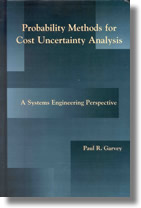 Probability Methods for Cost Uncertainty Analysis; A Systems Engineering Perspective offers a careful blend of theory and practice, providing a comprehensive approach for assessing the impact of unplanned events on the cost of engineering modern complex systems. Probability Methods for Cost Uncertainty Analysis; A Systems Engineering Perspective offers a careful blend of theory and practice, providing a comprehensive approach for assessing the impact of unplanned events on the cost of engineering modern complex systems.
Containing over 700 references, equations, and illustrations, and providing more than 100 theoretical and applied exercises, Probability Methods for Cost Uncertainty Analysis is suitable for cost, quality, reliability, and industrial engineers; systems engineers; cost and operations research analysts; management scientists; project and production engineers; engineering managers; and an extraordinary text for upper-level undergraduate and graduate students in these disciplines.
PAUL R. GARVEY is Chief Scientist for the Economic and Decision Analysis Center at The MITRE Corporation. He is the author of numerous technical papers, and book chapters, on cost uncertainty analysis and the application of decision theory methods to problems in risk management.
Risk Analysis: A Quantitative Guide
HC, 432 pp, $81.09
Vose, David
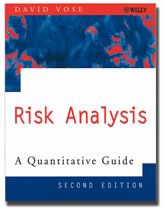 Risk and uncertainty are key features of most business and government problems and need to be understood for effective decisions to be made. This book describes the techniques you need for effective risk analysis. The book assumes you have basic knowledge of risk analysis (such as you would get from the @RISK manual) and builds upon that knowledge with detailed examples of proven risk analysis techniques. The author has built these techniques in over ten years of risk analysis consulting. Speaking of @RISK, this book features the world's best risk analysis software - @RISK, BestFit, and RISKview! By providing the building blocks, the author guides you through the necessary steps to produce an accurate risk analysis model and offers general and specific techniques to handle most modelling problems. Topics include basics on distributions and Monte Carlo simulation, building a risk analysis model, generating distributions from data and expert opinion, project risk analysis, times series projections, interpreting results, and more! Following the overwhelming success of the first edition, the second edition has been extensively revised and updated and will provide an invaluable practical guide for the analyst who must perform risk analysis, the decision maker who must review the results of a risk analysis, or the statistician or operations research specialist who is interested in practical applications of risk analysis. Clearly written and logically laid out, beginners and experts alike will benefit from this book. Risk and uncertainty are key features of most business and government problems and need to be understood for effective decisions to be made. This book describes the techniques you need for effective risk analysis. The book assumes you have basic knowledge of risk analysis (such as you would get from the @RISK manual) and builds upon that knowledge with detailed examples of proven risk analysis techniques. The author has built these techniques in over ten years of risk analysis consulting. Speaking of @RISK, this book features the world's best risk analysis software - @RISK, BestFit, and RISKview! By providing the building blocks, the author guides you through the necessary steps to produce an accurate risk analysis model and offers general and specific techniques to handle most modelling problems. Topics include basics on distributions and Monte Carlo simulation, building a risk analysis model, generating distributions from data and expert opinion, project risk analysis, times series projections, interpreting results, and more! Following the overwhelming success of the first edition, the second edition has been extensively revised and updated and will provide an invaluable practical guide for the analyst who must perform risk analysis, the decision maker who must review the results of a risk analysis, or the statistician or operations research specialist who is interested in practical applications of risk analysis. Clearly written and logically laid out, beginners and experts alike will benefit from this book.
Risk and Decision Analysis in Projects
Second Edition - SC, 259 pp, £27.50
John Schuyler
 Is there anything more important to the success of a project than making good decisions? Yet, few of us have had any formal training in decision making. Decision analysis is the discipline that helps people choose wisely under conditions of uncertainty. This book introduces risk and decision analysis applied to project management. Is there anything more important to the success of a project than making good decisions? Yet, few of us have had any formal training in decision making. Decision analysis is the discipline that helps people choose wisely under conditions of uncertainty. This book introduces risk and decision analysis applied to project management.
Probability is the language of uncertainty. Fortunately, a few basic concepts go a long way toward making better decisions. The evaluation calculations are straightforward, and many everyday problems can be solved with a hand calculator.
Recently we have seen heightened interest in probabilistic techniques for all types of evaluations. Shorter business cycles and increasing competition are demanding better resource management. People are learning more about value creation and how to work with uncertainty. New and evolving project management and risk software such as @RISK for Project, @RISK for Excel, PrecisionTree, and RISKOptimizer greatly help in assessing and managing risks and opportunities.
There are three major features of the decision analysis approach:
best judgments about risks and uncertainties are expressed as probability distributions; a project model establishes the outcome value for the possible scenarios; and the expected value (EV) calculation provides a probability-weighted value for decision making.
The benefits are improved accuracy in evaluations, risk characterisations, and clear communication. Decisions can be made faster and with more confidence. Many examples of applications of these concepts and the techniques of Monte Carlo simulation, decision trees, and optimisation are included in the book.
The methods apply to all types of project decisions. Decision analysis provides the only logical, consistent way to incorporate judgments about risks and uncertainties into an analysis. Thus, when the uncertainties are significant, these techniques are the best route toward credible project decisions. Armed with this book and DecisionTools software, you'll be making better project decisions in no time!
About the Author: John Schuyler, a longtime DecisionTools user, trains and assists clients in risk and economic decision analysis and in project risk management. He established Decision Precision®, an independent training and consulting practice in 1988, focusing on project and corporate economic modeling and on decision policy.
He has over 25 years of experience in economic evaluation, training, and management. His industry experience includes petroleum, mining, utilities, manufacturing, pharmaceuticals, information technology, and government.
Schuyler's short courses deal with strategy, design, resource, and capital investment decisions under uncertainty. He is associated with Oil & Gas Consultants International, for whom he has presented his three- to six-day courses over 150 times in 23 countries.
Simulation Modeling and Analysis
HC, 784 pp, $93.38
Averill M. Law & W. David Kelton
 An essential reference source, this book is intended for those more mathematically inclined. Ever wonder about how random numbers are generated? This book gives you the nitty gritty on random number generators and algorithms for generating a wide variety of random variates. There is material useful for @RISK and BestFit users, specifically on selecting input probability distributions. Amidst all the math, there are many graphs to visualise the various distributions. There's also a discussion of independence/dependence, and a section on fitting actual data to probability distributions. With over 700 pages, this book contains a wealth of information on simulation modelling that would be appropriate for those interested in risk analysis or system dynamics. An essential reference source, this book is intended for those more mathematically inclined. Ever wonder about how random numbers are generated? This book gives you the nitty gritty on random number generators and algorithms for generating a wide variety of random variates. There is material useful for @RISK and BestFit users, specifically on selecting input probability distributions. Amidst all the math, there are many graphs to visualise the various distributions. There's also a discussion of independence/dependence, and a section on fitting actual data to probability distributions. With over 700 pages, this book contains a wealth of information on simulation modelling that would be appropriate for those interested in risk analysis or system dynamics.
Simulation Modeling Using @RISK
SC, 226 pp, $46.71
Wayne Winston
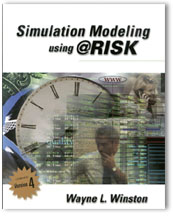 A straight-forward user guide to @RISK. This new book teaches basic concepts of simulation modelling using @RISK through a variety of examples from operations research, finance, marketing research, and accounting. These examples are accompanied by Excel and 1-2-3 @RISK models that clearly illustrate the concepts presented. You'll see how to use simulation to solve problems such as figuring an optimal bid, option pricing, market share analysis and inventory analysis. You can even simulate the never-ending Coke vs. Pepsi battle. Perfect for @RISK users wanting some tips and examples of simulation modelling techniques! Book comes with demonstration version of @RISK so you can follow along using the same example models in the book! A straight-forward user guide to @RISK. This new book teaches basic concepts of simulation modelling using @RISK through a variety of examples from operations research, finance, marketing research, and accounting. These examples are accompanied by Excel and 1-2-3 @RISK models that clearly illustrate the concepts presented. You'll see how to use simulation to solve problems such as figuring an optimal bid, option pricing, market share analysis and inventory analysis. You can even simulate the never-ending Coke vs. Pepsi battle. Perfect for @RISK users wanting some tips and examples of simulation modelling techniques! Book comes with demonstration version of @RISK so you can follow along using the same example models in the book!
“Makes the use of spreadsheet simulation easy and applicable to many every-day business problems. [Winston] will clearly be one of those unique and very few academic leaders that transcend the large void between theoretical teaching and practical, real world, business applications.” — Five stars, Amazon.com
Statistical Distributions, 3rd Ed.
SC, 221 pp, $56.13
Evans, Merran et. al.
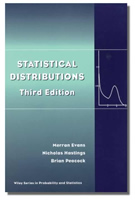 Finally there's a comprehensive source of information on the most important probability distributions. This text presents the key formulas, tables, diagrams and uses for the 39 most commonly used probability distributions. DecisionTools users will find additional information and technical documentation on the distributions used in @RISK and BestFit. This book serves both as a quick look-up reference source and a basic introduction to distributions. It even has formulas for generating random samples from each of the covered distributions. Highly recommended for anyone who works with probability distributions in areas such as risk analysis, data analysis and distribution fitting. Finally there's a comprehensive source of information on the most important probability distributions. This text presents the key formulas, tables, diagrams and uses for the 39 most commonly used probability distributions. DecisionTools users will find additional information and technical documentation on the distributions used in @RISK and BestFit. This book serves both as a quick look-up reference source and a basic introduction to distributions. It even has formulas for generating random samples from each of the covered distributions. Highly recommended for anyone who works with probability distributions in areas such as risk analysis, data analysis and distribution fitting.
Analyzing and Managing Risky Investments
HC, 485 pp, £69.95
Campbell, John M. Jr., Campbell, John M. Sr., and Campbell, Robert A.
 The rapidly growing area of formal risk assessment and management challenges those making investment decisions to approach the problem differently. Multiple texts document the tools and methodology of formal risk assessment quite successfully. This book addresses the broader issue of integrating modern risk methods with financial engineering and modern decision sciences to develop a logical, orderly decision process, suitable for individuals or large organisations. The discussion treats formal risk and optimisation methods within a holistic framework of decision-making, allowing the reader to understand that the process and metrics for valuing investment opportunities varies significantly between individual projects, business units or assets, and the enterprise. The rapidly growing area of formal risk assessment and management challenges those making investment decisions to approach the problem differently. Multiple texts document the tools and methodology of formal risk assessment quite successfully. This book addresses the broader issue of integrating modern risk methods with financial engineering and modern decision sciences to develop a logical, orderly decision process, suitable for individuals or large organisations. The discussion treats formal risk and optimisation methods within a holistic framework of decision-making, allowing the reader to understand that the process and metrics for valuing investment opportunities varies significantly between individual projects, business units or assets, and the enterprise.
Many DecisionTools techniques are implemented throughout the book, including Monte Carlo simulation, optimisation, optimisation with simulation, and decision trees. The book is full of discussions of how these techniques are applied to investment decisions. Concepts and examples discussed can be used directly with @RISK, Evolver, RISKOptimizer, and PrecisionTree.
The book provides an excellent reference for those familiar with risk and optimisation concepts, by including detailed examples of actual applications to real world projects, from simple decisions to multibillion dollar international applications. Though the concepts and techniques discussed are applicable to and intended for any investment situation, examples include those from the petroleum industry. Those new to the subject discover enough information to understand the power of the modern approaches, with enough insight into the language and practice of risk to move on to more detailed texts. Managers responsible for designing and implementing investment decision processes in their organisation will find the lessons invaluable.
@RISK Bank Credit Analysis
HC, 288 pp., $39.75
Ed Altman, Max L. Heine Professor of Finance, NYU Stern School of Business
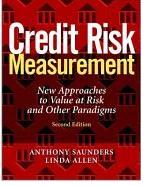 "Credit risk management and portfolio decisions on credit assets have become far more complex and controversial in recent years. Tony Saunders has written an important cogent summary and analysis of the various new models that have emerged in recent years to tackle these complexities. Never has this type of analysis been more relevant-a must read for credit practitioners, banking regulators, and researchers of financial institutions and markets." "Credit risk management and portfolio decisions on credit assets have become far more complex and controversial in recent years. Tony Saunders has written an important cogent summary and analysis of the various new models that have emerged in recent years to tackle these complexities. Never has this type of analysis been more relevant-a must read for credit practitioners, banking regulators, and researchers of financial institutions and markets."
Manuel Sebastiao, Executive Director, Insurance Supervisory Authority, Portugal
"For several years, bankers, professors and students alike have been searching in vain, looking for the "missing book" on credit risk measurement and models, a book that would combine an overarching perspective with practical advice on a subject increasingly important worldwide. Once again, Professor Saunders has come to the rescue in the nick of time, with Credit Risk Management-New Approaches to Value-at-Risk and Other Paradigms, a comprehensive volume that brings the necessary transparency to the issues that have heretofore been only translucent."
Decision Making Under Uncertainty with RISKOptimizer
$32.97
Winston, Wayne
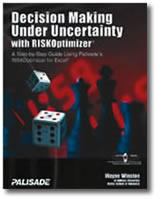 In Decision Making Under Uncertainty with RISKOptimizer, Wayne Winston, author of Palisade's best-selling Financial Models Using Simulation and Optimization once again offers models and techniques to find the best answers to business problems affected by uncertainty. Winston harnesses the power of Microsoft Excel along with Palisade's RISKOptimizer to solve business problems in areas such as inventory management, product mix decisions, capital budgeting, scheduling and more! Using Genetic Optimization and Monte Carlo simulation, optimal answers to previously unsolvable problems are now found! Managers from any industry will reap the benefits from this book. More than 30 example models ranging from job shop & production scheduling to retirement planning and options pricing are provided on the included CD-ROM as well. A trial version of RISKOptimizer, described by PC World as "a uniquely versatile business problem-solver" and "for many business problems, the most practical power tool around", is also included with the book. In Decision Making Under Uncertainty with RISKOptimizer, Wayne Winston, author of Palisade's best-selling Financial Models Using Simulation and Optimization once again offers models and techniques to find the best answers to business problems affected by uncertainty. Winston harnesses the power of Microsoft Excel along with Palisade's RISKOptimizer to solve business problems in areas such as inventory management, product mix decisions, capital budgeting, scheduling and more! Using Genetic Optimization and Monte Carlo simulation, optimal answers to previously unsolvable problems are now found! Managers from any industry will reap the benefits from this book. More than 30 example models ranging from job shop & production scheduling to retirement planning and options pricing are provided on the included CD-ROM as well. A trial version of RISKOptimizer, described by PC World as "a uniquely versatile business problem-solver" and "for many business problems, the most practical power tool around", is also included with the book.
Decisions Involving Uncertainty: An @ RISK Tutorial for the Petroleum Industry
SC, 150 pp, $44.07
Murtha, James
 A great extension of Murtha's highly successful seminars on the use of @RISK in the petroleum industry. You start here with 2 chapters to get up to speed on the philosophy of risk analysis and the requisite principles in probability, statistics, and Monte Carlo simulation. Following are the basic steps you'd take to actually build, run, and interpret results for a real risk analysis model in @RISK. To make it as hands-on as possible, Murtha includes lots of petroleum examples - an accompanying disk includes all these examples pre-built in Excel worksheets. Volumetric reserves, exponential decline, porosity and water saturation, waterflood prospect, and competitive bidding are some of the examples. This is a rare offering in that you'll learn about the concepts of risk analysis while also getting some very solid hands-on experience with risk analysis modelling in @RISK 4.5. A great extension of Murtha's highly successful seminars on the use of @RISK in the petroleum industry. You start here with 2 chapters to get up to speed on the philosophy of risk analysis and the requisite principles in probability, statistics, and Monte Carlo simulation. Following are the basic steps you'd take to actually build, run, and interpret results for a real risk analysis model in @RISK. To make it as hands-on as possible, Murtha includes lots of petroleum examples - an accompanying disk includes all these examples pre-built in Excel worksheets. Volumetric reserves, exponential decline, porosity and water saturation, waterflood prospect, and competitive bidding are some of the examples. This is a rare offering in that you'll learn about the concepts of risk analysis while also getting some very solid hands-on experience with risk analysis modelling in @RISK 4.5.
Dr. James Murtha has a Ph.D. in mathematics from the University of Wisconsin, and a Masters degree in petroleum and natural gas engineering from Penn State. He taught mathematics and petroleum engineering for 25 years and worked for or consulted extensively with Texaco, Chevron, Marathon, and S A Holditch & Associates. He has written papers and articles on Monte Carlo simulation, reservoir engineering, and spreadsheet applications, in addition to co-authoring two text books in mathematics. Now an independent consultant, Dr. Murtha is a registered petroleum engineer who presents seminars, teaches intensive training courses, and advises clients in risk analysis and other forms of decision making.
Dynamic Scheduling with Microsoft Project 2003
SC 575 pp, $62.96
Uyttewaal, Erik
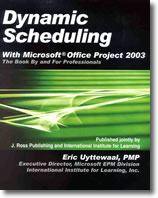 Dynamic Scheduling with Microsoft® Office Project 2003: The Book By and For Professionals, is based on the cumulative experience of the author, his clients, and other instructors, and includes insights from numerous other professionals who have used MS Office Project successfully. This unique guide gives a complete picture of how to achieve the best results with Microsoft Project. Dynamic Scheduling with Microsoft® Office Project 2003: The Book By and For Professionals, is based on the cumulative experience of the author, his clients, and other instructors, and includes insights from numerous other professionals who have used MS Office Project successfully. This unique guide gives a complete picture of how to achieve the best results with Microsoft Project.
This fully revised new edition of Eric Uyttewaal's best-selling book does more than describe the features of Microsoft Project. The author recommends certain features and argues against others - giving you a complete picture of how to use Microsoft Office Project 2003 to build a dynamic schedule that meets your need, not just once, but continuously.
Key features:
Fully aligned with the PMBOK 2004 edition,
Teaches how to build dynamic, easy-to-maintain project models,
Provides a checklist for good models of your project,
Provides many helpful screen illustrations, diagrams, stories, cartoons, review questions, case studies, and hands-on exercises to help make the learning process easy for all user levels,
An excellent companion for @RISK for Project users!
About the author: Eric Uyttewaal, PMP is Executive Director, Microsoft EPM Division, International Institute for Learning, Inc (www.iil.com)
Effective Risk Management - Some Keys to Success
HC 554pp, $84.95
Edmund H. Conrow
 The second edition of Dr. Conrow's book provides more than 700 tips to succeed and traps to avoid collected over a 20+ year period of implementing and evaluating project risk management. More than just a list of ideas, it provides solid fundamentals for each risk management process step, as well as numerous organizational and behavioral considerations, that can immediately improve any risk management process. Multiple approaches are provided in numerous places to permit the reader to "pick and choose" the approach best suited for their project. Examples are also provided to help the reader better understand and immediately apply the material to their project. The book can be used by every level of practitioner from novice to expert, and help you evaluate, tailor, and implement risk management on your project. The use of probability distributions and Monte Carlo simulation is covered, and includes lessons from work for industry, government, and commercial projects. The second edition of Dr. Conrow's book provides more than 700 tips to succeed and traps to avoid collected over a 20+ year period of implementing and evaluating project risk management. More than just a list of ideas, it provides solid fundamentals for each risk management process step, as well as numerous organizational and behavioral considerations, that can immediately improve any risk management process. Multiple approaches are provided in numerous places to permit the reader to "pick and choose" the approach best suited for their project. Examples are also provided to help the reader better understand and immediately apply the material to their project. The book can be used by every level of practitioner from novice to expert, and help you evaluate, tailor, and implement risk management on your project. The use of probability distributions and Monte Carlo simulation is covered, and includes lessons from work for industry, government, and commercial projects.
According to Dr. Lawrence D. Pohlmann, in the January 2004 issue of International Council on Systems Engineering journal INSIGHT, “The greatly expanded content and added usability feature have effectively transformed the second edition into an advanced risk management handbook”.
About the author: Dr. Conrow is a risk management and project management consultant with 20+ years experience; on hardware-intensive, software-intensive, and mixed projects, with life cycle dollar ranges from several million dollars to many billion dollars. Dr. Conrow has served as a risk manager and mentor to risk managers on a number of programmes, and has held long-term risk management and project management assignments where he has been responsible for making risk management work on a variety of programmes.
Financial Models Using Simulation and Optimization
$37.77
Winston, Wayne
 Financial Models is the most in-depth book written about using @RISK, Evolver and other DecisionTools software products to solve today's complex financial problems. The applications of simulation and optimisation in the book are new, novel approaches to options pricing, portfolio optimisation, acquisitions modeling, VAR (value-at-risk) and more! Financial Models is the most in-depth book written about using @RISK, Evolver and other DecisionTools software products to solve today's complex financial problems. The applications of simulation and optimisation in the book are new, novel approaches to options pricing, portfolio optimisation, acquisitions modeling, VAR (value-at-risk) and more!
Financial Models features years' worth of experience in setting up and solving complicated financial problems using Microsoft® Excel® and DecisionTools software. Learn valuable analytical techniques that help you get the most out of @RISK, Evolver, PrecisionTree® and TopRank®. Over 60 example problems show step-by-step how to set up and analyse each model. This is a practical, step-by-step guide that you can use immediately to build the models that you need!
The models in the book have been used at executive training classes at major corporations, including GM, NCR, PriceWaterhouseCoopers, and Bristol-Myers Squibb. All the models are included on CD-ROM along with trial versions of DecisionTools software.
Financial Models Using Simulation and Optimization II
$37.77
Wayne Winston
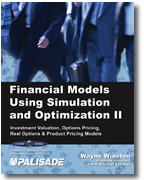 First published in 1998, Financial Models Using Simulation and Optimization quickly became one of the most widely used references for the application of simulation and optimisation techniques to financial problems. Now, author Wayne Winston has done it again with a totally new volume! Financial Models II is packed with real-life examples that demonstrate how @RISK, Evolver and Excel can be used to make better financial decisions. Winston's straightforward, step-by-step approach makes his innovative techniques accessible to anyone who uses Microsoft Excel. First published in 1998, Financial Models Using Simulation and Optimization quickly became one of the most widely used references for the application of simulation and optimisation techniques to financial problems. Now, author Wayne Winston has done it again with a totally new volume! Financial Models II is packed with real-life examples that demonstrate how @RISK, Evolver and Excel can be used to make better financial decisions. Winston's straightforward, step-by-step approach makes his innovative techniques accessible to anyone who uses Microsoft Excel.
Like its predecessor, Financial Models II features years' worth of experience in setting up and solving complicated financial problems using Microsoft Excel and DecisionTools software. You will learn valuable analytical techniques that will help you get the most out of @RISK, Evolver, and Excel. A wide variety of financial examples are presented and solved step-by-step in over 65 chapters. This isn't a book of long-winded theoretical discussions. It's a practical, step-by-step guide that you can use immediately to build the models that you need!
Integrating Corporate Risk Management
HC, 276 pp, $31.78
Prakash Shimpi
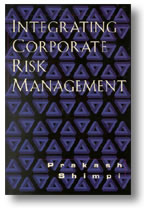 Risk cannot be avoided. It must be managed. In the rapidly changing risk environment faced by corporations, national boundaries have been pushed back and conventional market constraints diminished. New wholesale financial and risk management services offered by banks and reinsurers promise a more efficient use of capital and financial resources. Risk cannot be avoided. It must be managed. In the rapidly changing risk environment faced by corporations, national boundaries have been pushed back and conventional market constraints diminished. New wholesale financial and risk management services offered by banks and reinsurers promise a more efficient use of capital and financial resources.
How does a corporation manage the variety of risks it faces and the capital resources it has at its disposal? The author answers this question without entangling us in technical jargon, keeping the math to a minimum. The analysis relies strongly on the role played by individuals as they manage their corporation's risk appetite and capital resources.
This book contributes a common risk management framework - the Insurative Model - that can be used by the risk manager, the treasurer, and the CFO. Shimpi argues that it is not necessary for every manager to use the same risk management technique. What matters is that they adopt the same framework that embraces a common view of risk.
Just as capital management and risk management are linked in a successful corporation, there are strong links between corporate finance and insurance, between the treasurer and the risk manager, between single risks and integrated risks, and between separate markets and converging markets. Indeed, it is the importance of these links that leads Shimpi to call this analysis not a "handbook" on risk management, but an "and" book.
About the Author: Prakash A. Shimpi has an extraordinarily wide and deep experience in financial and capital markets. He is Managing Principal (U.S.) for Swiss Re New Markets. Swiss Re is a leading reinsurance firm with a worldwide reputation for innovation in financial techniques and instruments. Before joining Swiss Re in 1995, Shimpi was managing director of the Global Insurance Corporate Finance Division of Chase Manhattan Bank. Previously, he had been vice president and manager of the Insurance Portfolio Strategies Group at Drexel Burnham Lambert.
Shimpi earned his bachelor and masters degrees from the London School of Economics and Political Science and an MBA in finance and international business from the University of Chicago. He is a Fellow of the Society of Actuaries and a chartered financial analyst.
"This book is full of groundbreaking, powerful ideas presented in a very accessible manner."
Anurag Saksena
Managing Director, GMAC-RFC
"Shimpi tells his clients to overcome their preoccupation with the debt-to-equity ratio and to concentrate instead on the underlying issues: How much capital does the company need, and how much should be on and off the balance sheet to minimise its total cost?"
The Economist
Managing Risk in Organizations
$42.08
J. Davidson Frame
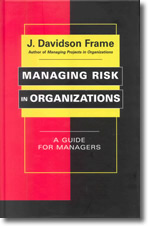 Managing Risk in Organizations offers a proven framework for handling risks across all types of organisations. In this comprehensive resource, David Frame— a leading expert in risk management— examines the risks routinely encountered in business, offers prescriptions to assess the effects of various risks, and shows how to develop effective strategies to cope with risks. In addition, the book is filled with practical tools and techniques used by professional risk practitioners that can be readily applied by project managers, financial managers, and any manager or consultant who deals with risk within an organisation. Managing Risk in Organizations offers a proven framework for handling risks across all types of organisations. In this comprehensive resource, David Frame— a leading expert in risk management— examines the risks routinely encountered in business, offers prescriptions to assess the effects of various risks, and shows how to develop effective strategies to cope with risks. In addition, the book is filled with practical tools and techniques used by professional risk practitioners that can be readily applied by project managers, financial managers, and any manager or consultant who deals with risk within an organisation.
Managing Risk in Organizations is filled with illustrative case studies and:
Outlines the various types of risk: pure, operational, project, technical, business, and political Reveals what risk management can and cannot accomplish Shows how to organise risk management efforts to conduct risk assessments, manage crises, and recover from disasters Includes a systematic risk management process: risk management planning, risk identification, qualitative impact analysis, quantitative impact analysis, risk response planning, and monitoring control Provides quantitative and qualitative tools to identify and handle risks This much-needed book will enable organisations to take risk seriously and act proactively.
About the Author: J. Davidson Frame is Dean of Academic Affairs at the University of Management and Technology (UMT) in Arlington, Virginia. Prior to joining UMT, he established the project management programme at George Washington University. He also served as director of the Project Management Certification Program at the Project Management Institute (PMI) and has served on PMI’s board of directors. Frame has authored more than forty articles and seven books.
Managing Risk in Organizations provides a compendium of information, techniques and tools for managing risk. It is essential reading for new managers and corporate analysts who deal with uncertainty.
Operational Risk Modelling and Analysis: Theory and Practice
HC, 360 pp, $178
Marcelo G. Cruz
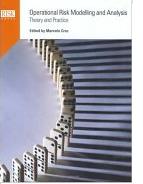 The definitive journey into operational risk - this new multi-contributor title will guide you with the identification, modelling, implementation, analysis and integration of operational risk into your overall risk management framework. The definitive journey into operational risk - this new multi-contributor title will guide you with the identification, modelling, implementation, analysis and integration of operational risk into your overall risk management framework.
Enables you to make more informed decisions on how to identify and avoid the potential risks as well as fully understand the acceptable risks on a cost-benefit basis.
Divided under three main sections:
- Database Modelling, Regulatory and Technical Issues;
- Risk Modelling and Measurement;
- Case Studies of Implementation of Operational Risk Projects in Large Financial Institutions.
Highlights integral issues such as how to spot the links between indicators of operational risk and the potential losses.
Examines the tensions inherent in the nature of operational risk at both quantitative and qualitative levels.
Outlines the practical day-to-day issues and illustrates workable methodologies with examples, case studies and cutting-edge analysis.
Provides an even mix of both the progressive and in-depth research taking place in academic institutions as well as the actual practical implementation issues.
Provides the tools to cope with differing and complex situations within operational risk.
Edited by Marcelo Cruz, a world-renowned leading expert on operational risk modelling and measurement.
Operational Risk: Practical Approaches to Implementation
HC, 360 pp, $178
Ellen Leander Davis
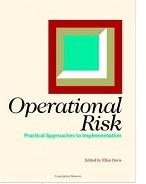 Topical, innovative and highly practical, this authoritative new resource from Risk Books will help you successfully develop and enhance the operational risk function in your firm. Topical, innovative and highly practical, this authoritative new resource from Risk Books will help you successfully develop and enhance the operational risk function in your firm.
Highly practical focus explains operational risk regulatory matters and specifically aids you with the practical implementation of an operational risk programme in your organisation.
Provides easy access to the very latest thinking on Operational risk from the biggest names in the field including: Marco Moscadelli, Marcus Haas, Thomas Kaiser and Maurits Bakker.
Collates the latest, most influential and ground-breaking work recently published in, among others, Operational Risk magazine.
Makes it easy for first-timers to implement a regulatory compliance framework by providing an essential route-map that clearly shows you how to do this effectively and efficiently.
Split into 4 easy access sections:
- Loss data collection and modelling – offers a range of novel, practical approaches to solve the notoriously complex challenges associated with the collection and modelling of internal and external loss data.
- Alternative measurement strategies – with detailed guidance on key risk indicators and scenario testing among other alternative tools, this section offers highly practical solutions informed by ‘real life' situations.
- Conceptualising operational risk management – all about turning operational risk measurement into action – this section will help you conceptualise your op risk approach and outline an effective implementation strategy.
- Mitigation strategies – the ultimate goal of most operational risk strategies, here you will find a range of invaluable case-studies to provide a definitive assessment of the growing mitigation techniques available.
About the Author
Ellen Davis is the editor of Operational Risk magazine and BaselAlert.com, based in London. Previously, she was an editor on Risk magazine, and the editor of AsiaRisk magazine, based in Hong Kong. She originally hails from New York City, where she had a long freelance career during which her work appeared in Treasury & Risk Management, Global Finance, BusinessWeek, CFO magazine, and a number of other financial publications. She holds a BA from Wellesley College and an MBA from New York University.
Modeling, Measuring and Hedging Operational Risk
HC, 346 pp, $125
Marcelo G. Cruz
 Worldwide banks are keen to find ways of effectively measuring and managing operational risk , yet many find themselves poorly equipped to do this. Operational risk includes concerns about such issues as transaction processing errors, liability situations, and back-office failure. Measuring and Modelling Operational Risk focuses on the measuring and modelling techniques banks and investment companies need to quantify operational risk and provides practical, sensible solutions for doing so. Worldwide banks are keen to find ways of effectively measuring and managing operational risk , yet many find themselves poorly equipped to do this. Operational risk includes concerns about such issues as transaction processing errors, liability situations, and back-office failure. Measuring and Modelling Operational Risk focuses on the measuring and modelling techniques banks and investment companies need to quantify operational risk and provides practical, sensible solutions for doing so.
Author is one of the leading experts in the field of operational risk. Interest in the field is growing rapidly and this is the only book that focuses on the quantitative measuring and modelling of operational risk. Includes case vignettes and real-world examples based on the author's extensive experience.
Essential reading for all professional risk managers, irrespective of their particular lens of perception. Provides a complete quantitative reference for all those involved in modeling and managing operational risk as well as for those involved with developing hedging products for operational risk within insurance companies and derivatives houses
VBA for Modelers: Developing Decision Support Systems with Microsoft Excel
HC, 549 pp, $73.95
S.Christian Albright
 Self-contained and extremely practical, VBA for Modelers guides you in developing customised decision support systems for the important business problems you face. The book gives students and professionals the ability to integrate spreadsheet models with the power and flexibility of Microsoft Excel's Visual Basic for Applications (VBA). When used in conjunction with @RISK 4.5's extensive VBA commands library, users will gain almost unlimited control over @RISK for Excel! Self-contained and extremely practical, VBA for Modelers guides you in developing customised decision support systems for the important business problems you face. The book gives students and professionals the ability to integrate spreadsheet models with the power and flexibility of Microsoft Excel's Visual Basic for Applications (VBA). When used in conjunction with @RISK 4.5's extensive VBA commands library, users will gain almost unlimited control over @RISK for Excel!
The first half of the book is a helpful primer, which covers the basics of VBA including:
Working with Excel ranges, workbooks, worksheets, and charts General programming concepts Control logic (if-then-else constructions) Loops, arrays, and subroutines The Visual Basic Editor (VBE) Excel's Solver add-in Building dialog boxes Debugging and error handling
Following the primer, you will learn how VBA and Excel can be used to create specific decision support applications based upon those found in the best-selling Practical Management Science, also available from Palisade Europe UK Ltd. Examples include:
This book features a companion Web site that provides detailed explanations of the subprograms and related information, as well as a CD-ROM containing example programs.
|


























